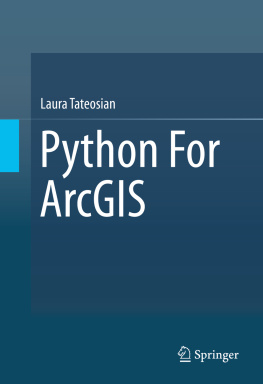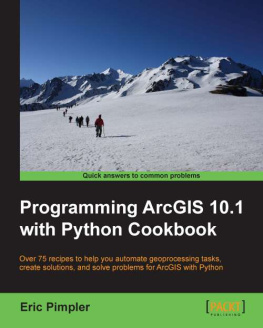Pimpler - Programming ArcGIS Pro with Python (2nd Edition)
Here you can read online Pimpler - Programming ArcGIS Pro with Python (2nd Edition) full text of the book (entire story) in english for free. Download pdf and epub, get meaning, cover and reviews about this ebook. year: 2021, publisher: Technics Publications, genre: Computer. Description of the work, (preface) as well as reviews are available. Best literature library LitArk.com created for fans of good reading and offers a wide selection of genres:
Romance novel
Science fiction
Adventure
Detective
Science
History
Home and family
Prose
Art
Politics
Computer
Non-fiction
Religion
Business
Children
Humor
Choose a favorite category and find really read worthwhile books. Enjoy immersion in the world of imagination, feel the emotions of the characters or learn something new for yourself, make an fascinating discovery.

Programming ArcGIS Pro with Python (2nd Edition): summary, description and annotation
We offer to read an annotation, description, summary or preface (depends on what the author of the book "Programming ArcGIS Pro with Python (2nd Edition)" wrote himself). If you haven't found the necessary information about the book — write in the comments, we will try to find it.
Pimpler: author's other books
Who wrote Programming ArcGIS Pro with Python (2nd Edition)? Find out the surname, the name of the author of the book and a list of all author's works by series.
Programming ArcGIS Pro with Python (2nd Edition) — read online for free the complete book (whole text) full work
Below is the text of the book, divided by pages. System saving the place of the last page read, allows you to conveniently read the book "Programming ArcGIS Pro with Python (2nd Edition)" online for free, without having to search again every time where you left off. Put a bookmark, and you can go to the page where you finished reading at any time.
Font size:
Interval:
Bookmark:



Installing Exercise Data for this Book
- Open a web browser and download the dataset from:
- http://geospatialtraining.com/programming-arcgis-pro-with-python-2nd-edition/
- Using Windows Explorer or File Explorer create a c:\Student folder on your computer.
- Unzip the downloaded exercise data to the c:\Student folder
- The final folder structure should be c:\Student\ProgrammingPro . There will be a number of subfolders under ProgrammingPro .

the Python Language
- Commenting code
- Importing modules
- ArcGIS Notebooks
- Creating variables
- Using built-in data types (strings, numbers, lists, dictionaries)
- Manipulating strings
- Using classes and objects
- Decision support statements
- Looping structures
- Handling errors with try/except
- Using functions
- Working with files
Font size:
Interval:
Bookmark:
Similar books «Programming ArcGIS Pro with Python (2nd Edition)»
Look at similar books to Programming ArcGIS Pro with Python (2nd Edition). We have selected literature similar in name and meaning in the hope of providing readers with more options to find new, interesting, not yet read works.
Discussion, reviews of the book Programming ArcGIS Pro with Python (2nd Edition) and just readers' own opinions. Leave your comments, write what you think about the work, its meaning or the main characters. Specify what exactly you liked and what you didn't like, and why you think so.










